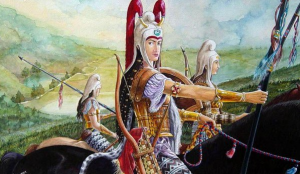The origin of the word Amazon may have come from the Iranian language. The work ha-mazan (phonetic pronunciation) meant warrior and the nomadic Scythians that migrated into the eastern European region are believed to have been Indo-Iranian tribes so the etymology of the word seems right. As the Scythian nomads moved across the area, described in Herodotus’ third story of their origin, a stratified society developed in which the farmers and herders (the earlier inhabitants) were lower status and the newer Scythian warrior class became the royal or ruling class.
However, unlike most societies that are absorbed by a warrior based culture, this one did not immediately or exclusively denigrate women to the lowest status. It seems that in their world there was a place for the warrior woman, a practice perhaps influenced by their female deities. Herodotus believed that the Samatians were the result of the merging of the Scythian and Amazon cultures. Whether this acceptance came from the merging of a society, such as the Amazonians that already had such practices, or it was inherent in the customs of the early nomads is not clear, but archaeological evidence shows that women both as warriors and as high status individuals existed in the Scythian society and similar cultures in the region of Pazyryk.
The Scythians buried their high status dead in mounds called kurgans or tumuli. The dead were laid out often as if asleep in a hollowed out log, facing the east. Grave goods included fine clothes, jewellery, food, cannabis, hand mirrors (also carried by the followers of Hathor), horse tack, bows, swords, shields, entire chariots and often other humans and horses. The horses were sacrificed by axe blow and then buried with the deceased. A later excavation, such as the one of the Pazyryk mummy known as the Ice Maiden excavated by Natalia Polosmak, has shown that at least in this instance the horses were older rather than younger stock suggesting a hint of practicality when killing the livestock. The bodies were mummified in a complex process involving the removal of internal organs, packing the body cavity with aromatic herbs and spices and then embalming the flesh with oils and resin. Some of the kurgans also filled with ground water and subsequently sealed the mummies in ice which further preserved all of the burial goods. The craftsmanship of the gold work, textiles, leather items and wood carving is exceptional and equally so for both male and female burials.
Read more HERE
Ask me anything
Explore related questions





